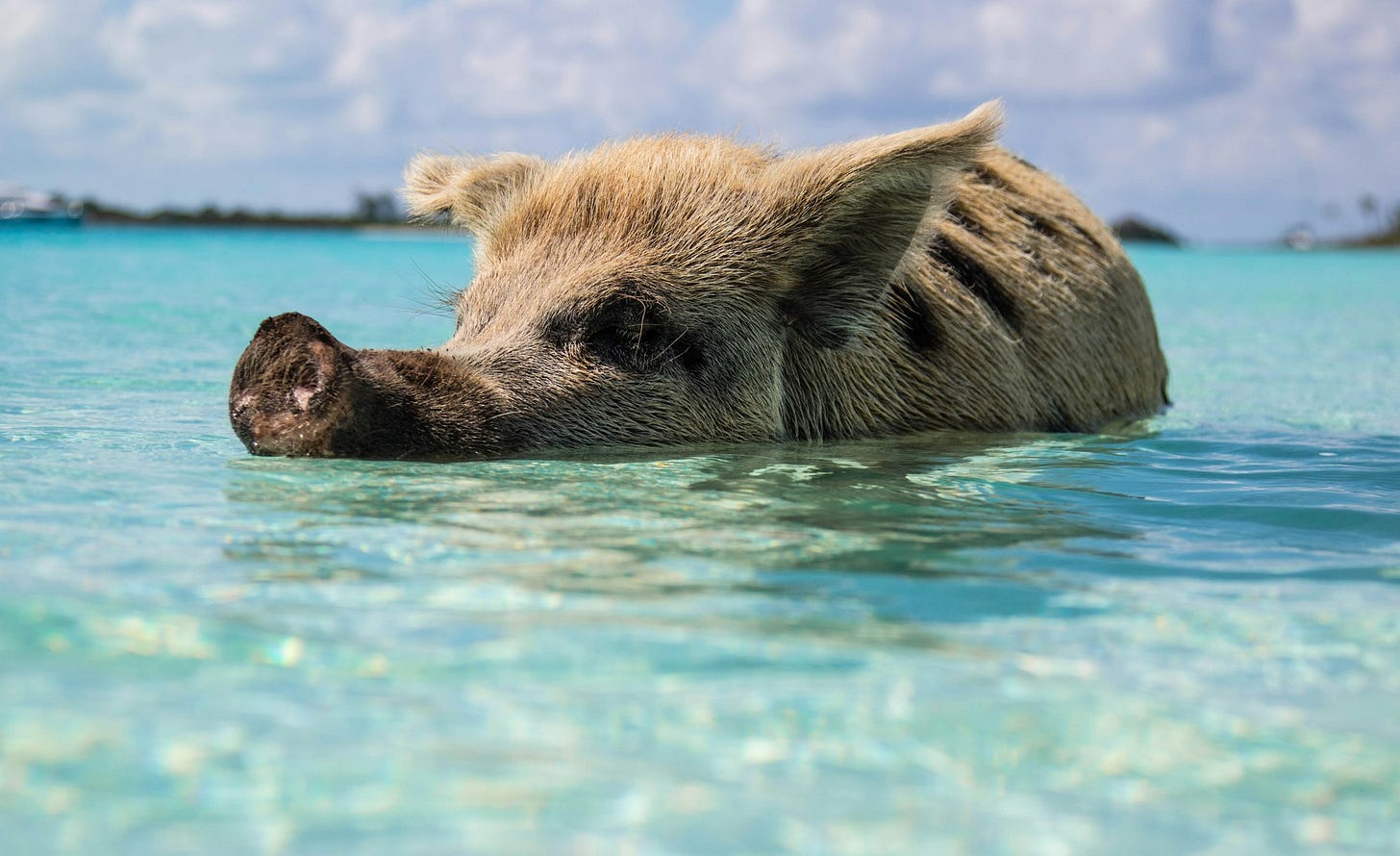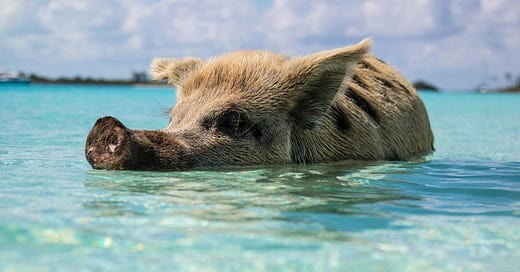Why did some Polynesian island societies lose their pigs?
Some island peoples extirpated their pigs after establishing them. Was it planned due to competition for plant foods with humans?

I happened across an interesting article from last year by Christina Giovas that looks at pigs in Polynesia. People carried pigs with them to most of the islands that they colonized, excepting some distant and relatively recent places such as Rapa Nui (Easter Island) and New Zealand. These places presumably didn't get pigs, either because sufficient numbers did not survive the initial ocean voyage, because of low rates of subsequent contacts that might have brought pigs, or because the necessary forage for pigs was not present in sufficient quantity to establish them—especially since pigs and people compete for many of the same foods.
But some islands that didn't have pigs at the time of European contact nevertheless have ancient archaeological evidence of pigs. So people brought pigs to those islands and established them, but they subsequently died out.
Here are the key paragraphs form Giovas' introduction:
Nonetheless, archaeological data in combination with the accounts of early European explorers reveal a pattern of pig distribution far more extensive in prehistory than at the time of historic contact (Fig. 1) (Alien et al. 2001; Bay-Petersen 1983; Bellwood 1987; Dye and Steadman 1990; Kirch 1991, 2000b; Kirch and Yen 1982; Rolett 1998), suggesting that prehistoric Polynesians either allowed swine herds to die out or intentionally exterminated them. Whichever of these is the case, it appears that pig extirpation in Polynesia constitutes one of the few known instances of domestic species extinction (Ramis and Bover 2001), making it highly significant to the history of human-domesticate interactions.
It has been suggested that animal husbandry was simply less feasible on resource-impoverished islands (Anderson 2001, 2002; Bay-Petersen 1983; Kirch 2000b), particularly since husbandry practices involved feeding pigs cultivated crops, setting up an element of resource competition between pigs and their Polynesian keepers. Underlying this explanation are assumptions about island ecology and its impact on pigs and humans alike. Although the relationship is seldom made explicit, these ecological factors are presumed to operate according to principles of island biogeography, particularly the relationship of island area to species extinction. Other factors may also influence the likelihood of extinction, including island geology, elevation, and latitude and longitude. Here I test the relationship between pig extirpation and these variables. I propose that the pattern of prehistoric distribution for domestic pigs in Polynesia may be best understood in island biogeographic terms and that resource competition may represent the overarching causal mechanism driving pig extirpation, as Kirch (2000b) has argued. To begin, I offer a brief overview of the role of pigs in Polynesian society, followed by a discussion of the relevant principles of island biogeographic theory and the mechanisms-both environmental and cultural-that may have brought about pig extirpation in Polynesia (Giovas 2006:69-70).
Obviously, on the islands where pigs were extirpated, humans were a factor in killing them. But there is this question: did extirpation sometimes result from a deliberate plan, where people recognized that the pigs were eating vegetable foods the people needed themselves? Or did they just eat all the pigs, possibly during a shortfall, and not restock them from other islands?
In times of resource shortfall, pigs would have been effectively competing with people for the same agricultural produce, placing Polynesians in a position in which the benefits of pig husbandry may have been outweighed by its relatively high economic (energetic) cost. As Kirch and others have suggested (Alien et al. 2001; Bay-Petersen 1983; Kirch 2000b), trophic competition on this level may explain why animal husbandry failed in many parts of Polynesia. Those islands prone to resource shortfalls would have been at a greater risk for failure of pig husbandry simply because crop harvests may have been insufficient to support both humans and pigs. The onset of this effect need not have been sudden or severe. Instead, it may have operated slowly but systematically over decades or more (Giovas 2006:72).
Since many of the islands were in periodic contact with other societies, pigs might have redispersed in a number of cases, and possibly pigs were maintained over long times on some islands that otherwise would have lost them by recurrent contact. Giovas approached this issue of "social isolation" in an interesting way:
On the other hand, where human interaction between islands was frequent, it may have supplied a type of rescue effect (Brown and Kodric-Brown 1977) in which the continual immigration of domesticates safeguarded against their disappearance from an island. In this scenario, isolation comprises not only a geographic but also a social component in which substantial geographic isolation may be overcome in part by cultural forces. Weisler (1994, 1995, 1996, 1997; Woodhead and Weisler 1997), for example, has documented the existence of a long-distance economic interaction sphere among the remote islands of Mangareva and the Pitcairn group. The subsequent decline of settlements on Pitcairn and Henderson may have come about in part because of the breakdown of interisland voyaging between these islands (Giovas 2006:75, emphasis in original).
This concept of social isolation serving as a substitute for geographic isolation is very interesting to me; it adds a historically fluctuating component to the usual isolation factor treated by biogeographers.
Giovas found that island area was a strong predictor of whether pigs were extirpated, with most of the cases of pig loss being relatively small islands. That is in line with the prediction of island biogeography, at least in terms of the ability of larger islands to support more species within a given ecological space.
Island elevation was also related; extirpation was more likely on very level atolls. But it wasn't clear that this correlation remained true after controlling for island area; the two have a strong relationship. Still, a higher island might be one where humans have more trouble using all resources, as some remain at altitudes or on slopes used only occasionally by people. In other words, a higher island has more potential "wilderness" space where feral pigs might escape and avoid capture.
I find myself wondering whether an additional historical component may be important. Pig populations have the potential of growing quite a bit faster htan human populations, especially when human consumption of them is relatively low and natural forage is available. In other words, during the early years after a colonization, pigs may have grown faster than people.
But later in time, the people caught up in many islands; putting more and more pressure on the ecological space available to both people and pigs. In these contexts, the pigs would have lost out. So demographic growth and competition between humans and pigs predicts a pattern in which many islands start with pigs, but then lose them as human populations catch up and overtake them in size.
We might predict on this demographic basis that pigs would have died out on other, larger islands if Polynesian history had continued without interruption from European explorers. No island was likely to have been a steady-state with equilibrium in pig and human population sizes, although the joining of nearby islands into interacting culture groups might have moderated the effect.
Reference:
Giovas CM. 2006. No pig atoll: island biogeography and the extirpation of a Polynesian domesticate. Asian Perspectives 45:69-95. JSTOR



